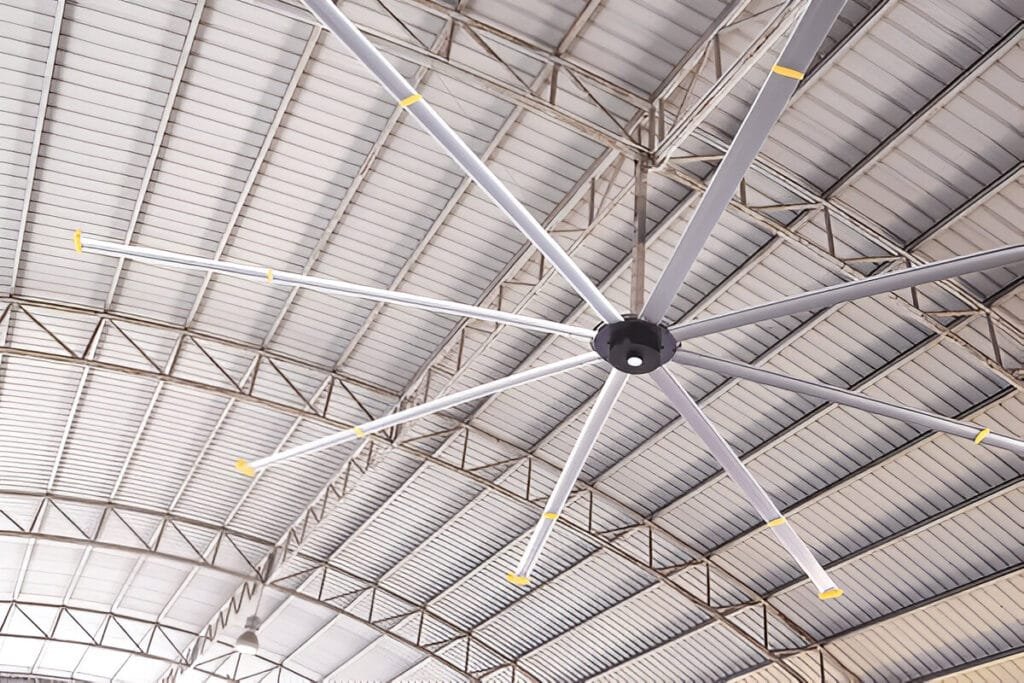What Is the Difference Between Cross Flow Fan and Centrifugal Fan
A concise comparison of the key differences between cross flow fans and centrifugal fans for various applications.
Read More
In the world of industrial machinery, fans play a crucial role in various applications, from ventilation to cooling. High-speed fans and low-speed fans are two distinct categories that cater to different requirements.
This blog post will delve into the key distinctions between high-speed and low-speed fans, including their design, operating principles, and typical use cases.

High-speed fans, also known as standard ceiling fans, are a popular choice for residential and smaller commercial spaces. These fans typically range from 36 to 56 inches in diameter and operate at higher rotational speeds compared to HVLS fans. High-speed fans are designed to create a direct, cooling breeze that can effectively lower the perceived temperature in a room.
Low-speed fans, also known as high-volume, low-speed (HVLS) fans, are a type of ceiling fan designed to move large volumes of air at slower speeds. Unlike standard ceiling fans, which typically range from 36 to 52 inches in diameter, HVLS fans are much larger, with diameters ranging from 6 to 24 feet. These fans are engineered to provide efficient airflow and air circulation in large, open spaces such as warehouses, manufacturing facilities, agricultural buildings, and commercial spaces.


When comparing high-speed fans and low-speed fans, also known as high-volume, low-speed (HVLS) fans, there are several key differences to consider. These include airflow characteristics, size and design, energy efficiency, and noise levels.
High-speed fans typically operate at higher rotational speeds, measured in revolutions per minute (RPM), which results in a more concentrated and directional airflow. This makes them effective for spot cooling or targeted air circulation in smaller areas.
HVLS fans are designed to move large volumes of air at slower speeds. They create a gentle, consistent airflow that can cover a wide area. The slower speed of HVLS fans allows for more efficient mixing of air, leading to improved temperature control and indoor air quality.
High-speed fans are typically smaller, ranging from 18 to 30 inches in diameter, and are mounted on walls or ceilings. They often have multiple speed settings and can be oscillating or stationary.
HVLS fans are much larger, with diameters ranging from 6 to 24 feet. They are designed for mounting at ceiling level and feature long, aerodynamically shaped blades that optimize airflow. The large size of HVLS fans allows them to move substantial volumes of air while operating at slower speeds, making them suitable for spaces with high ceilings and large floor areas.
While high-speed fans can effectively cool small areas, they consume more energy due to their higher rotational speeds.
HVLS fans are designed with energy efficiency in mind. Despite their large size, they operate at slower speeds, which results in lower energy consumption compared to multiple high-speed fans.
High-speed fans, due to their higher rotational speeds, tend to produce more noise.
HVLS fans, thanks to their slower operating speeds, generate significantly less noise.


High-speed fans are a popular choice for industrial settings, such as warehouses, manufacturing facilities, and automotive shops. These environments often require powerful, directional airflow to maintain a comfortable working temperature and improve air quality. High-speed fans can effectively move large volumes of air, providing cooling and ventilation in these spacious areas.
Gyms and fitness centers can benefit from the strong, targeted airflow provided by high-speed fans. During intense workouts, high-speed fans help keep exercisers cool and comfortable by increasing air circulation and evaporative cooling. This is particularly important in areas with high humidity levels, where the increased airflow can help reduce heat stress and maintain a more pleasant environment.
High-speed fans are an efficient solution for outdoor events and venues, such as concerts, festivals, and sporting events. These fans can provide a refreshing breeze for attendees, helping to combat high temperatures and improve overall comfort. High-speed fans can be strategically placed to maximize airflow throughout the venue, ensuring a more enjoyable experience for all.
Greenhouses and agricultural buildings require precise temperature and humidity control to maintain optimal growing conditions. High-speed fans can help regulate the environment by providing consistent airflow and ventilation. These fans can be used to circulate air, remove excess heat, and control humidity levels, promoting healthy plant growth and reducing the risk of disease.


Low-speed HVLS fans are an ideal solution for large commercial spaces, such as warehouses, distribution centers, and manufacturing plants. These fans can move substantial volumes of air at a slower speed, providing gentle, consistent airflow throughout the space. By circulating air from the ceiling to the floor level, HVLS fans can help maintain a comfortable temperature and improve overall air quality.
HVLS fans are increasingly used in livestock barns and agricultural facilities to provide effective cooling and ventilation. These fans create a gentle, steady breeze that helps regulate temperature and humidity levels, reducing heat stress on animals and promoting their overall health and well-being. In addition, the improved air circulation provided by HVLS fans can help minimize the concentration of odors and harmful gases, ensuring a healthier environment for both animals and workers.
Low-speed HVLS fans are a practical and energy-efficient solution for airports and transportation hubs. These large, open spaces require significant air movement to maintain a comfortable environment for travelers and employees. HVLS fans can provide a gentle, consistent airflow that helps regulate temperature and improve indoor air quality, creating a more pleasant experience for everyone in the facility.
Places of worship and auditoriums can benefit from the quiet, efficient operation of HVLS fans. These fans can provide ample air circulation without producing disruptive noise levels, ensuring a comfortable environment for congregants and audiences. The slow, steady airflow generated by HVLS fans can help maintain a consistent temperature throughout the space, reducing the need for additional cooling systems and leading to long-term energy savings.
Fans are generally more effective when placed higher in a room. Ceiling fans or fans mounted high on the wall can better circulate air throughout the entire space. Floor fans or low-mounted fans may provide more direct cooling but tend to have a more limited range of air circulation.
Higher fan speeds can provide more powerful cooling and air circulation. However, the ideal fan speed depends on the specific needs of the room and the preferences of the occupants. Higher speeds are better for quickly cooling down a space, while lower speeds are suited for maintaining a comfortable temperature and gentle air circulation.